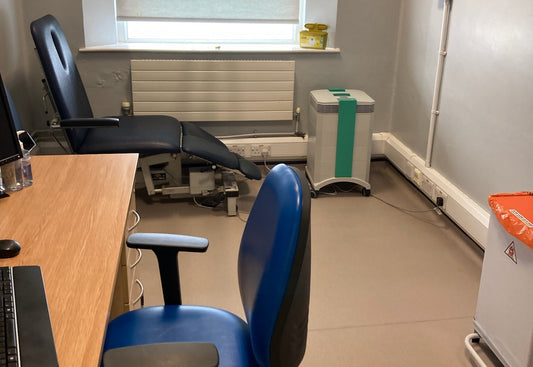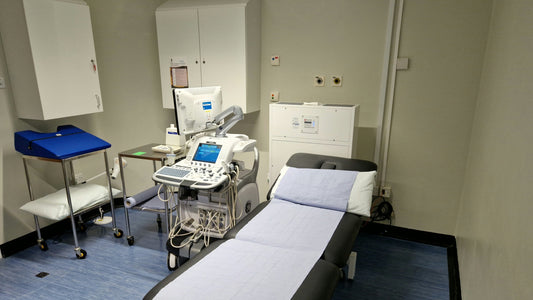To support patient and staff safety and reduce the risk of airborne transmission of COVID-19 in hospital settings, air filtration and purification units can offer a quick and cost-effective solution.
This post summarises some of the evidence for the efficacy regarding the ability of standalone HEPA filtration systems in reducing viral contamination in healthcare settings.
HEPA filtration efficacy in capture and containment of disease similar in particle size of SARS-CoV-2 is well documented.
A recent study[1] examining the role of air purifiers as a supplementary measure to remove airborne SARS-CoV-2 highlighted that:
“the peak concentration of SARS-CoV-2 aerosols appears in two distinct size ranges, one in the submicron region with aerodynamic diameter dominant between 0.25 and 1.0 μm, and the other peak in supermicron region with diameter larger than 2.5 μm. Such aerosols just fall in the size range that can be effectively removed by air purifiers.”
It continues: “According to our previous measurements, the efficiencies of HEPA are more than 95% for aerosols of diameter between 0.25 and 1.0 μm and nearly 100% for those with diameter larger than 2.5 μm.”
The study concludes that in:
“health care settings without enough ventilation provided by their existing ventilation system, or none at all, use of indoor air purifiers may be an effective supplementary measure to improve the dilution of indoor air contaminated with virus-laden aerosols.”
This has similarly been concluded in earlier studies in dental care settings, where air purifiers have been shown to reduce the health-care workers' exposure to aerosols and droplets significantly.[2]
Two trials have been conducted that have indicated that the IQAir Cleanroom air purifiers can achieve a 99.9% reduction of airborne viruses in less than 10 minutes in a room of nearly 30m3. This study was undertaken by an independent biomedical research organisation specializing in aerobiology – Airmid Healthgroup. Further independent studies have also shown IQAir to be effective in reducing MSRA viral contamination by 75% - 93% within patient rooms[3] and invasive aspergillosis infections by 50%.[4]
The US Centres for Disease Control and Protection has shown that under certain conditions people with COVID-19 can infect others that are over 6ft away, and that this often occurs within enclosed spaces with poor ventilation.[5] Equally, the German government has recently highlighted that the risk of COVID-19 transmission can be reduced through consistent ventilation and the appropriate use of ventilation technologies, and is now investigating air filtration units in schools and other environments.[6]
With such innovations available to help prevent viral contamination, it is important to raise awareness of the benefits of these systems in light of COVID-19.
To discuss how high-performance HEPA filtration is used throughout the NHS and private hospitals to combat COVID-19, and how the systems can help you meet your airborne hygiene needs, speak to one of our air quality experts today at 0203 176 0524 or email us at: info@CommercialAirFiltration.co.uk
[1] Zhao B et al. Air purifiers: A supplementary measure to remove airborne SARS-CoV02. Building and Environment. June 2020. Available: https://www.ncbi.nlm.nih.gov/pmc/articles/PMC7180358/
[2] Chen C. The effectiveness of an air cleaner in controlling droplet/aerosol particle dispersion emitted from a patient's mouth in the indoor environment of dental clinics. Journal of the Royal Society. December 2009. Available: https://doi.org/10.1098/rsif.2009.0516
[3] Confirmed effectiveness in controlling viruses. British Dental Journal volume 229, page204 (2020), Available: https://www.nature.com/articles/s41415-020-2042-
[4] T C Boswell, P C Fox, Reduction in MRSA environmental contamination with a portable HEPA-filtration unit. Journal of Hospital Infection, 2006 May;63(1):47-54. Available: https://pubmed.ncbi.nlm.nih.gov/16517004/
[5] The Times. Virus can live 28 days on phone screens. October 2020. Available: https://www.thetimes.co.uk/article/virus-can-live-28-days-on-phone-screens-5tlnfn9wd
[6] Opinion of the Indoor Air Hygiene Commission of the Federal Environment Agency. August 2020. Available: https://www.umweltbundesamt.de/sites/default/files/medien /2546/dokumente/irk_stellungnahme_lueften_sars-cov-2_0.pdf




